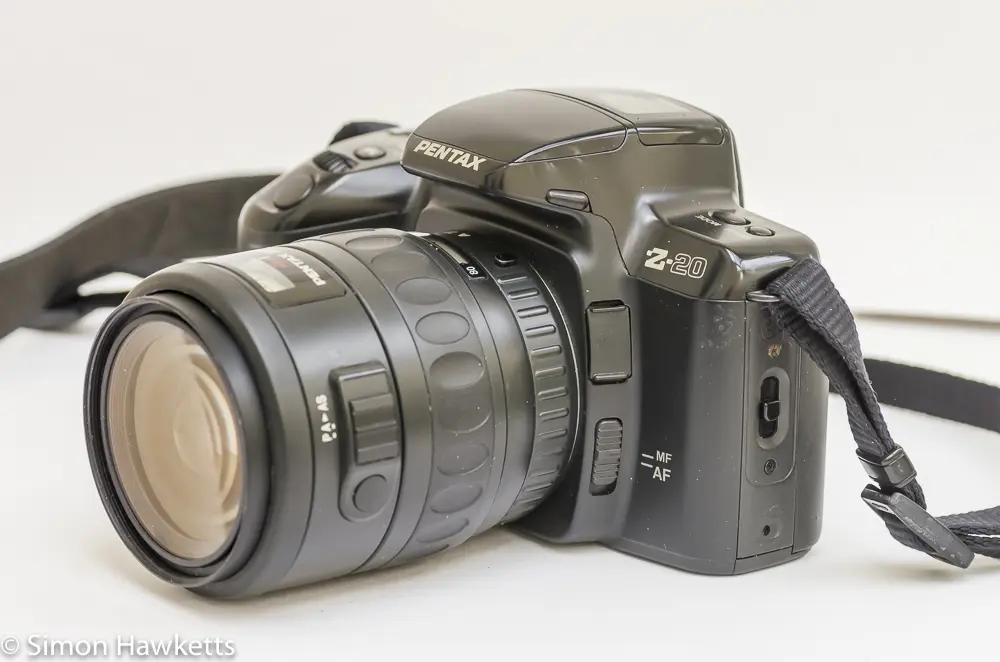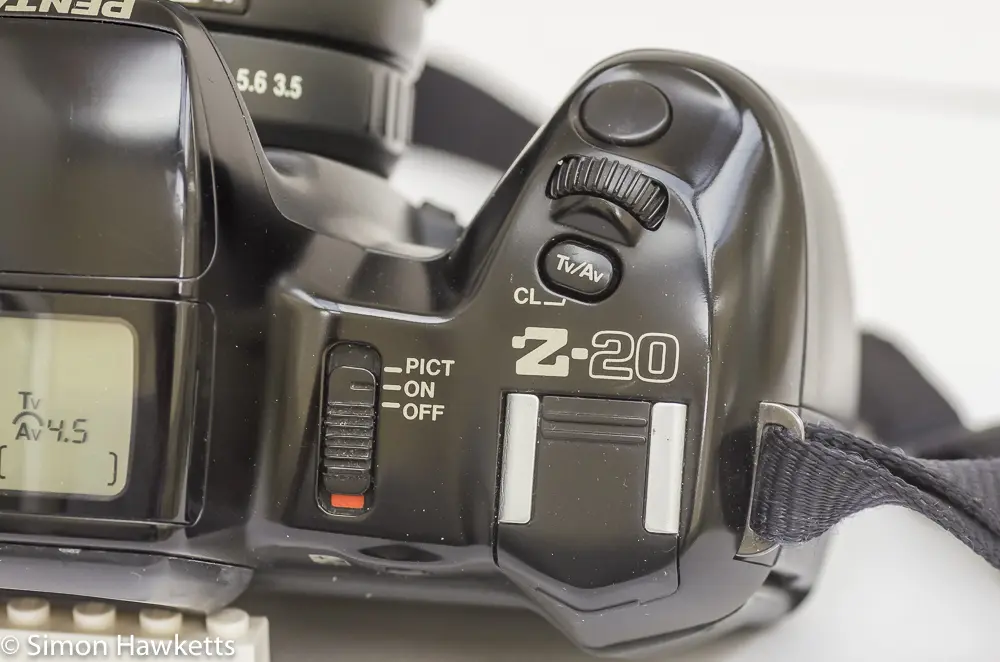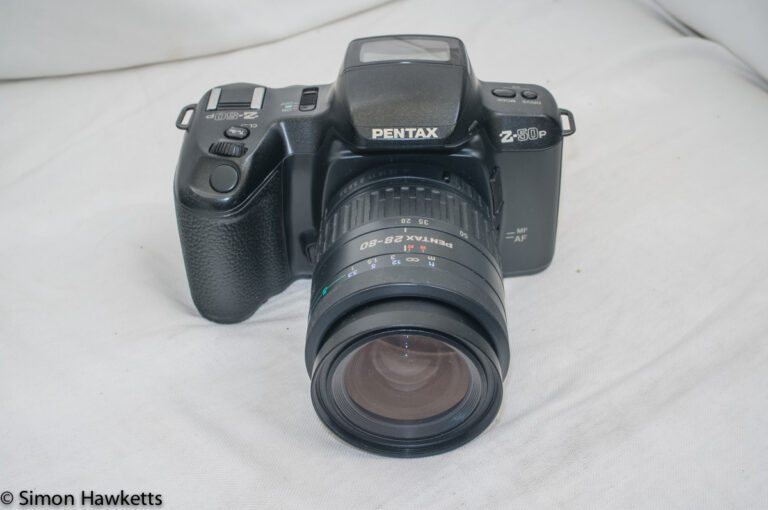Pentax Z-20 35 mm autofocus SLR review
This is a review of one of the best specified models in the Pentax Z series of autofocus 35 mm film cameras – the Pentax Z-20. This is one of the not so well known models in the Pentax range, but one that I think is a bit of a star once you get to know it.
Pentax Z-20 Images













My Pentax Z-20 Camera
This Pentax Z-20 was bought to compliment my other Pentax Z series cameras, a Z-1 and Z-1p which represent the top end of the Z series, and a Z-10 which is the simplest camera in the range.
I found it on eBay with a 28 to 80 power zoom lens, and it looked a bit sorry because the front of the lens had a large dent in it. I assumed the dent was probably just in the filter and since no one else was interested, and it was only £15 I placed a bid at the last moment and that is what I paid for it.
When the camera turned up a couple of days after completing the transaction, I discovered it is a very clean unit with no cosmetic damage, although it didn’t work when I turned it on. I assumed the battery was probably flat, so I fitted a new one and tried turning it on again. This time there were some whirring noises, and the top LCD showed an icon of a film canister. There wasn’t a film in the camera, but after I’d opened the back door and then shut it again the camera went through its loading routine and then everything sprung to life.
I was glad to find that the attached lens seemed to be in fully working order. When I bought my Z-1p, the power zoom functions were not working because the switch had been broken, but now I have a functioning version to pair with any of my Z series cameras.
Pentax Z-20 description
The 1980s were not a great period for attractive camera design, producing some of the ugliest cameras I can think of, but fortunately by the early 1990s when the Pentax Z series were introduced things had improved somewhat. I think it’s because designers had re-introduced some curves and therefore removed some of the very ‘blocky’ look that cameras like the Ricoh XR-X and Canon T70 had. I think the Z-20 is therefore not too bad in appearance, although not as attractive as the MZ series or the earlier M series.
It is still very much a ‘button press’ camera, with buttons for selecting most functions and a two position rocker control to make changes. Although I’m not fond of buttons to change camera controls, it works better in the Z series than in some of the other implementations I’ve come across.
The Z-20 has a great set of exposure and drive modes and covers quite a lot of the functionality of its big brother, the Z-1. It is obviously more of a consumer camera, however, with the inclusion of scene modes which give the option of more automatic operation.
Control Layout
The control layout on the Z-20 is a simplified version of the Z-1. There are mode and drive buttons which, when held, allow the user to toggle through the various modes the camera offers using the main control wheel. The main On/Off switch has two positions which turn the camera on with the first setting and then puts the camera into ‘scene’ mode when pushed to its extreme.
The shutter button is at the front of the hand grip and is easy to get to, and the main control wheel sits just behind it. There is a button further behind the control wheel which toggles between Aperture priority and Shutter priority when in Auto mode, and an exposure compensation dial sits on the back panel.
All the controls generally work in the same manner – a button is pressed and the control wheel alters a setting.
I’ve used the term control wheel several times, but in truth it isn’t a wheel but a back and forth toggle switch, which I don’t particularly like. Even so, it’s quite convenient to use and works quite well with the camera to the eye.
Exposure Modes
The Z-20 has all the exposure modes that most of us want and use on modern cameras. The individual modes are selected by pressing the Mode button on the left-hand side of the camera and using the main control dial to switch exposure modes.
The modes available depend to a certain extent on the lens fitted to the camera. If a lens with an A setting is fitted, the camera can offer Program mode, Auto mode (which covers aperture priority and shutter priority) and fully manual mode. If the lens doesn’t have the A setting, then the Program mode isn’t available because the camera can’t control the aperture setting. This also means that the Auto mode won’t offer the shutter priority option for the same reason. With an A mode lens fitted, the Tv/Av button toggles the main control dial to adjust the set aperture or the set shutter speed, switching the camera between aperture priority or shutter priority.
In Manual mode, the exposure compensation button performs the same function as the green button on a modern Pentax DSLR. When pressed, it meters the scene and sets the camera to the correct exposure, which can then be shifted from that position with the control dial. It’s also possible to set one parameter, for example the aperture, and use the exposure compensation button to meter and set the other parameter. I find this system of manual exposure really convenient to use.
If the On/Off switch is pushed to the top of its travel, the camera moves into scene mode and offers 5 different scene options. The top choice is green mode, which is every thing is completely automatic, and the photographer just points the camera and presses the button. There are then 4 different scene modes available, which are basically just different formula for determining the choice of aperture/shutter speed and therefore depth of field etc in any particular situation.
The Z-20 makes it a little more interesting, however, by using the program shift option to alter the scene mode. For example, when in Portrait program mode, the main control wheel can shift the depth of field from narrow to wider and this is represented on the LCD as a series of dots building a line between an icon showing a portrait and an icon showing a landscape. The manual explains how this function can be used to learn the photographer’s particular tastes, but I found it more complex setting it up than it was worth.
Metering
The Z-20 has a 6 segment averaging metering system which gives a pretty good coverage of the scene being photographed. This averaged system is in use in all modes except manual exposure, when the camera switches to spot metering. Although this isn’t as convenient as being able to manually switch to spot metering in all exposure modes, the manual exposure system is so easy to use that it seems to work quite well.
Autofocus
The Z-20 belongs to Pentax’s second generation of autofocus cameras, and I found it to be pretty responsive and accurate in most situations. There is a single autofocus point in the centre of the frame, which I found fine. In fact, on my Pentax K5 I normally only have the centre focus point active and focus / re-frame, so I found it the most convenient way to work. It works in surprisingly low light conditions as well – I’ll see how accurately when I develop the first film from the camera.
Viewfinder and LCD information
The viewfinder information is similar to the level of information shown in the Z-1p. There is a small panel on the right-hand side of the viewfinder screen which shows the aperture and shutter speed (if the aperture can be displayed – some lenses can’t be read), a focus indicator and a bar chart which shows either any exposure compensation applied to the picture, or the exposure level in manual mode and how far it is away from the metered value.
The centre of the viewfinder is engraved with the autofocus area, but unlike modern digital cameras, the focus point doesn’t light up when focus is achieved. I guess with only one sensor, there isn’t any question as to which focus point was used!
The other area which shows camera information is the LCD on the top of the prism housing. This shows the exposure mode selected, aperture, shutter speed, any exposure compensation etc and is pretty clear and easy to read. I didn’t find a way of illuminating the LCD, however, which makes it less useful than the version on the Z-1.
This camera is fitted with a Penta mirror rather than a prism, so the image is not a bright as the Z-1 especially when using a slow power zoom lens, but it’s reasonable when used with a 50 mm f/1.7 Pentax standard lens.
In Use
The Pentax Z-20 is a smaller camera than the Z-1, and consequently it’s a bit lighter and easier to carry around. The control layout and viewfinder information makes it a nice experience to shoot with, and I found the general performance to be OK. Obviously the autofocus doesn’t have the same abilities as a modern DLSR with tracking, or the same almost instance response, but for a screw driven lens it works quite well.
I found the power zoom a bit of an annoyance because it has various modes which try to automatically keep objects the same size in the frame, or return to certain focal lengths, and I found these were seemingly randomly being enabled. It could be that the contacts on the enabling switch on my lens are making intermittent contact, but I ended up turning the zoom to manual, which I felt more comfortable with.
I normally use Aperture priority mode, but during the film test with this camera I tried most of the modes, and I’ll assess how well they turn out once I’ve developed the film.
One thing I did find awkward was using the camera when an external flash was fitted to the hot shoe. There are lots of reasons why it’s better to have the flash off-centre, but I did find it difficult to get to the main on/off switch.
The Z-20 is a pretty full-featured camera which actually seems to perform nicely and has a lot of going for it. In fact, since it’s possible to find one for only a few pounds, and it has a lot of the feature set of a Z-1 I would say it’s a bit of an unrecognized gem. It will take all Pentax K mount lenses, it’s reasonably small and light, and it doesn’t suffer from the problems the admittedly more attractive, smaller and lighter MZ series suffered from, namely the dreaded mirror motor problems.
I’ve covered the more important spec points here and not things like the zoom functions and program shift learning mode, Pentax functions etc, but for more details of those I would recommend the manual which is available here. In the meantime, if you find a Z-20 for only a few pounds, and you are a fan of Pentax and autofocus cameras, I’d say this is a bit of a bargain.
Update: The photos I took with the first film I ran through this camera are available in another post here.
Pentax Z-20 specifications
- Pentax Z-20 35mm autofocus slr
- Program mode, Aperture & Shutter priority, Manual mode and BU (Bulb) mode
- 5 scene modes with program shift
- 6 segment TTL averaged metering + Spot metering in manual mode
- ISO range 6-6400
- Motor driven film transport with single, multiple and self timer modes and auto loading
- Auto rewind of film with mid-roll option
- Shutter speeds 1/2000 to 30 sec (stepless in auto modes)
- Pentax Kaf2 mount takes all Pentax K mount lenses
- Single sensor auto-focus
- DX coding with override
- Plastic body
- One 2CR5 battery required for operation
- Body Ser No: 6042188
- Lens Ser No:3402615
- Manual available on-line here.
Discover more from Everything Vintage
Subscribe to get the latest posts sent to your email.







